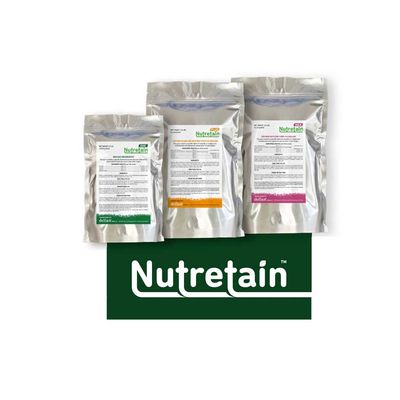

- Home
- Companies
- Dellait - Animal Nutrition & Health
- Products
- Nutretain Silage Inoculants

Nutretain Silage Inoculants
Nutretain is a science-based forage preservation technology that synergistically combines multiple bacteria strains with high-activity enzymes to speed the fermentation process increasing lactic acid production while improving dry matter recovery and forage quality over a broad range of crops. Additionally, Nutretain silage inoculants work as very effective preservatives. Nutretain treated silages produce moderate concentrations of acetic acid during fermentation; this is beneficial because acetic acid inhibits yeasts and molds, resulting in improved stability when silage is exposed to air. In fact, silages with very low concentrations of acetic acid may be unstable upon feed-out (Kung et al., 2018). When acetic acid from silages is consumed by ruminants, it can be absorbed from the rumen and used for energy or be incorporated into milk or body fat.
The goal of making silage is to produce a stable feed with a high recovery of dry matter, energy, and highly digestible nutrients compared with the fresh crop.
Nutretain One
Crop Usage
· Legume and grass haylage
· Small grain silage
Enzymes
· Amylase
· Xylanase
· Cellulase
Features
· High levels of fibrolytic enzymes to break down the fiber in these crops.
· Releases glucose from plant cell walls to fuel fermentation.
· Enhance the nutritive value of silage by increasing the digestibility of cell walls.
Packaging
1 lb. (453.6 g) foil pouch
Amount treated
200 tons of fresh forage
Nutretain Plus
Crop Usage
· Legume and grass haylage
· Small grain silage
· Corn and sorghum silage
Bacteria Strains
· Pediococcus pentosaceus
· Enterococcus faecium
· Lactobacillus plantarum
Enzymes
· Amylase
· Xylanase
· Cellulase
Features
· Effective levels of fiber and starch digesting enzymes combined with LAB to fuel a fast, efficient fermentation.
· Oxygen scavenging.
· High lactic and acetic acid production for greater aerobic stability.
· For use at 2x rate on weather stressed grass or legume haylage.
Packaging
2.5 lb. (1,134 g) foil pouch
Amount treated
1000 tons of fresh forage
Nutretain Max
Crop Usage
· High-moisture grains
· Earlage
· Snaplage
Bacteria Strains
· Pediococcus pentosaceus
· Enterococcus faecium
· Lactobacillus plantarum
Enzymes
· Alpha-Amylase
· Gluco-Amylase
· Xylanase
Features
· Very high levels of 2 starch digesting enzymes to maximize glucose release with high levels of LAB designed to enhance fermentation and digestibility.
· Oxygen scavenging.
· Enhanced lactic and acetic acid production for greater aerobic stability and starch digestibility in corn and sorghum grains.
Packaging
2.5 lb. (1,134 g) foil pouch
Amount treated
500 tons (18,000 bushels)
- Proven efficacy by research & field trials
- Increases nutrient value & silage digestibility
- Enhances forage palatability & dry matter intake
- Improves dairy & beef cattle performance
- Easy to mix & non-corrosive to equipment
- Cost effective
